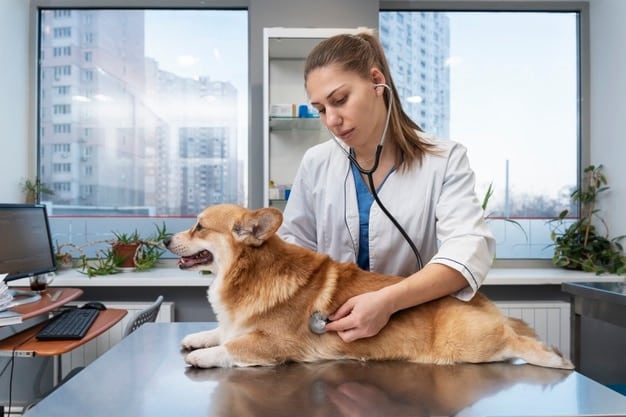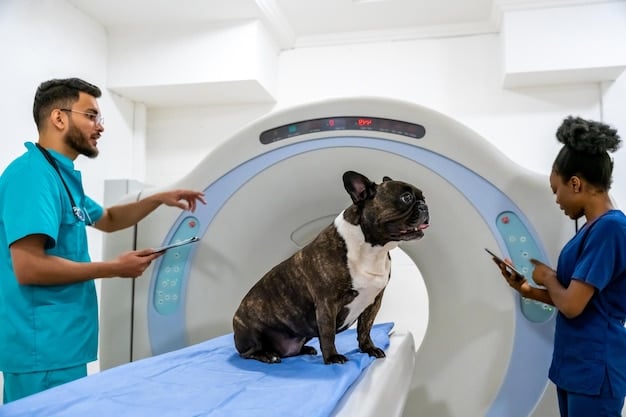Understanding and Managing Seizures in Pets: A Comprehensive Guide

Seizures in pets can be alarming, but understanding the causes, management, and support options is crucial for pet owners to provide the best possible care and improve their pet’s quality of life.
Witnessing a seizure in your beloved pet can be a frightening experience. This guide aims to provide a comprehensive understanding of seizures in pets, covering their causes, effective management strategies, and ways to offer support to your furry friend.
What are Seizures in Pets?
Seizures in pets are characterized by sudden, uncontrolled electrical disturbances in the brain. These events can manifest in various ways, ranging from brief staring spells to full-blown convulsions. Recognizing that a seizure is occurring and understanding its potential impact is the first step in providing appropriate care and seeking veterinary assistance.
Types of Seizures in Pets
Seizures can be categorized into different types based on their presentation and underlying causes. Generalized seizures affect the entire brain, leading to a loss of consciousness and full-body convulsions. Focal seizures, on the other hand, originate in a specific area of the brain and may cause localized symptoms such as twitching or repetitive movements. Understanding the type of seizure your pet experiences can help your veterinarian determine the best course of treatment.
Recognizing a Seizure
Identifying a seizure can be challenging, especially if it’s your pet’s first one. During a generalized seizure, your pet may collapse, lose consciousness, and exhibit rhythmic jerking movements. They might also drool, urinate, or defecate. Focal seizures can be more subtle, with symptoms such as facial twitching, lip licking, or staring blankly. Pay close attention to any unusual behaviors and consult with your veterinarian if you suspect your pet is having seizures.

- Generalized Seizures: Involve the entire body and loss of consciousness.
- Focal Seizures: Affect a specific area of the brain, causing localized symptoms.
- Cluster Seizures: Multiple seizures occurring within a short period.
- Status Epilepticus: A prolonged seizure lasting more than 5 minutes, requiring immediate veterinary intervention.
Being able to identify the different types of seizures and knowing what to expect during each episode is critical for providing supportive care. Early recognition and prompt veterinary intervention can significantly improve your pet’s outcome. Remember to remain calm and observant during a seizure to provide accurate information to your veterinarian.
Potential Causes of Seizures in Pets
Seizures in pets can stem from a variety of underlying causes, ranging from genetic predispositions to acquired medical conditions. Identifying the root cause is essential for developing an effective treatment plan and managing your pet’s condition. A thorough diagnosis by your veterinarian is crucial in determining the underlying reason for the seizures.
Genetic Factors
Certain breeds of dogs and cats are predisposed to seizures due to genetic factors. Epilepsy, a neurological disorder characterized by recurrent seizures, can be inherited in some breeds. If your pet belongs to a breed known to be at higher risk for epilepsy, it’s important to be vigilant for any signs of seizure activity.
Underlying Health Conditions
Seizures can also be caused by underlying health conditions such as brain tumors, infections, metabolic disorders, and exposure to toxins. These conditions can disrupt normal brain function and trigger seizure activity. Diagnostic tests such as blood work, MRI, and spinal fluid analysis may be necessary to identify the underlying cause of your pet’s seizures.
Environmental Toxins
Exposure to certain toxins can also induce seizures in pets. Common household substances such as antifreeze, rodenticides, and certain medications can be toxic to animals and cause neurological damage. Keeping these substances out of your pet’s reach is essential for preventing seizures and other health problems.
- Idiopathic Epilepsy: Seizures with no identifiable underlying cause.
- Brain Tumors: Abnormal growths in the brain that can trigger seizure activity.
- Infections: Brain infections like encephalitis can cause seizures.
- Toxins: Exposure to substances like lead or certain plants can induce seizures.
Understanding the possible causes of seizures in pets is vital for ensuring they receive proper medical care. If your pet experiences a seizure, it’s essential to seek veterinary attention to diagnose any underlying health conditions or toxic exposures. Early diagnosis and treatment can significantly improve your pet’s prognosis and overall well-being.
Diagnosing Seizures in Pets
Diagnosing seizures in pets requires a thorough approach, combining detailed history, physical examinations, and advanced diagnostic tests. The goal is to identify the underlying cause of the seizures and rule out other potential conditions that may mimic seizure activity. A precise diagnosis is crucial for creating an effective treatment plan tailored to your pet’s specific needs.
Veterinary Examination and History
The first step in diagnosing seizures involves a comprehensive veterinary examination. Your veterinarian will ask detailed questions about your pet’s medical history, including any previous illnesses, medications, and potential exposure to toxins. They will also inquire about the characteristics of the seizures, such as their frequency, duration, and any associated symptoms.
Diagnostic Tests
To identify the underlying cause of seizures, your veterinarian may recommend a variety of diagnostic tests. Blood tests can help detect metabolic disorders, infections, or toxic exposures. MRI or CT scans can provide detailed images of the brain, allowing the veterinarian to identify tumors, structural abnormalities, or areas of inflammation. Spinal fluid analysis may also be performed to rule out infections or inflammatory conditions affecting the brain.
Ruling out Other Conditions
It’s important to rule out other conditions that may resemble seizures, such as fainting spells, muscle tremors, or behavioral problems. Your veterinarian will carefully evaluate your pet’s symptoms and perform appropriate tests to differentiate seizures from other potential causes.

Accurate diagnosis of seizures in pets is essential for effective management and care. By combining detailed history, thorough physical examinations, and advanced diagnostic tests, veterinarians can identify the underlying cause of seizures and develop a treatment plan that addresses your pet’s specific needs, improving their quality of life.
Managing Seizures in Pets: Treatment Options
Managing seizures in pets typically involves a combination of medication, lifestyle adjustments, and supportive care. The primary goal is to reduce the frequency and severity of seizures while minimizing potential side effects. Working closely with your veterinarian is essential for developing a treatment plan that meets your pet’s individual needs.
Anticonvulsant Medications
Anticonvulsant medications are the cornerstone of seizure management in pets. These drugs help to control electrical activity in the brain and reduce the likelihood of seizures. Common anticonvulsants used in veterinary medicine include phenobarbital, potassium bromide, and levetiracetam. The choice of medication will depend on factors such as the type of seizures, the pet’s overall health, and potential drug interactions.
Lifestyle Adjustments
In addition to medication, certain lifestyle adjustments can help manage seizures in pets. Maintaining a consistent routine, avoiding stressful situations, and providing a safe environment can reduce the risk of triggering seizures. It’s also important to monitor your pet closely for any signs of seizure activity and keep a record of any seizures that do occur.
Supportive Care
During a seizure, it’s important to provide supportive care to protect your pet from injury. Clear the area around your pet of any sharp objects or other hazards. Do not attempt to restrain your pet or put your hands in their mouth, as this could result in injury. Once the seizure has ended, provide comfort and reassurance to help your pet recover.
- Medication Compliance: Administer anticonvulsant medications as prescribed by your veterinarian.
- Regular Monitoring: Keep a seizure diary to track seizure frequency, duration, and severity.
- Dietary Management: Some pets may benefit from dietary changes to support brain health.
- Stress Reduction: Minimize stressors in your pet’s environment to reduce seizure triggers.
Effective management of seizures in pets requires a multimodal approach that combines medication, lifestyle adjustments, and supportive care. By working closely with your veterinarian and diligently following the treatment plan, you can help your pet live a happy and fulfilling life despite their seizure disorder.
Providing Support During and After a Seizure
Providing support during and after a seizure is crucial for ensuring your pet’s safety and well-being. Knowing how to respond appropriately can help minimize the risk of injury and provide comfort during a stressful time. Your calm and informed response can make a significant difference in your pet’s recovery.
During a Seizure
During a seizure, your primary focus should be on protecting your pet from injury. Clear the area around your pet of any sharp objects or other hazards. Do not attempt to restrain your pet or put your hands in their mouth, as this could result in injury. Time the seizure from start to finish to provide accurate information to your veterinarian.
After a Seizure
After a seizure, your pet may be disoriented, confused, or tired. Allow them to rest in a quiet, comfortable place and provide reassurance as they recover. Offer water and a small meal if they are able to eat, but do not force them. Monitor your pet closely for any signs of recurring seizure activity or other complications.
Documenting Seizures
Keeping a detailed record of your pet’s seizures is essential for effective management. Note the date, time, duration, and any associated symptoms of each seizure. This information can help your veterinarian assess the effectiveness of the treatment plan and make any necessary adjustments.
- Stay Calm: Your composure will help your pet remain calm.
- Ensure Safety: Clear the area of hazards to prevent injury.
- Comfort Your Pet: Speak in a soothing voice after the seizure.
- Monitor Recovery: Observe your pet for any lingering effects or recurring seizures.
Supporting your pet during and after a seizure involves ensuring their safety, providing comfort, and documenting the details of the episode. By remaining calm and informed, you can help your pet recover more quickly and provide valuable information to your veterinarian for ongoing management.
When to Seek Emergency Veterinary Care
Knowing when to seek emergency veterinary care for seizures is critical for ensuring your pet receives timely and appropriate treatment. Certain situations require immediate veterinary intervention to prevent serious complications and protect your pet’s health. Recognizing these urgent situations can be life-saving.
Prolonged Seizures
A seizure that lasts longer than five minutes, known as status epilepticus, is a medical emergency. Prolonged seizures can cause brain damage, overheating, and other serious complications. If your pet experiences a seizure lasting longer than five minutes, seek veterinary care immediately.
Cluster Seizures
Cluster seizures, defined as multiple seizures occurring within a short period, also warrant immediate veterinary attention. These seizures can quickly exhaust your pet’s energy reserves and lead to potentially life-threatening complications. Seek veterinary care if your pet experiences multiple seizures within a 24-hour period.
First-Time Seizures
If your pet experiences a seizure for the first time, it’s important to seek veterinary care to determine the underlying cause. While not all first-time seizures are emergencies, it’s essential to rule out any serious medical conditions or toxic exposures. Your veterinarian can perform a thorough examination and recommend appropriate diagnostic tests.
- Seizure Duration: Any seizure lasting longer than 5 minutes requires emergency care.
- Cluster Seizures: Multiple seizures in a short period are an emergency.
- Breathing Difficulty: If your pet struggles to breathe after a seizure, seek immediate help.
- Unresponsiveness: Prolonged unresponsiveness after a seizure is a critical sign.
Recognizing the signs that indicate the need for emergency veterinary care is crucial for ensuring your pet receives timely and appropriate treatment. Prolonged seizures, cluster seizures, and breathing difficulties are all urgent situations that require immediate veterinary intervention to prevent potentially life-threatening complications. When in doubt, always err on the side of caution and seek veterinary advice.
| Key Point | Brief Description |
|---|---|
| ⚠️ Recognizing Seizures | Knowing the signs of different types of seizures is crucial for timely intervention. |
| 💊 Medication Management | Administering anticonvulsants as prescribed is essential for controlling seizures. |
| ⏱️ Emergency Situations | Prolonged or cluster seizures necessitate immediate veterinary care. |
| 🏠 Home Safety | Creating a safe environment minimizes the risk of injury during a seizure. |
Frequently Asked Questions (FAQ)
Stay calm and ensure your pet’s safety by clearing the area of any hazards. Do not try to restrain your pet or put anything in their mouth. Time the seizure and contact your veterinarian afterward.
Common causes include genetic factors, underlying health conditions like brain tumors or infections, and exposure to toxins. Diagnostic tests can help determine the specific cause of your pet’s seizures.
Treatment usually involves anticonvulsant medications to control electrical activity in the brain. Lifestyle adjustments, such as maintaining a consistent routine and reducing stress, can also help manage seizures.
Seek emergency care if your pet has a seizure lasting longer than five minutes, experiences cluster seizures (multiple seizures in a short period), or has difficulty breathing after a seizure.
Some pets may benefit from dietary changes that support brain health. Consult with your veterinarian to determine if a specific diet is appropriate for your pet’s condition and overall health.
Conclusion
Understanding seizures in pets, their causes, and management strategies is essential for providing optimal care and improving your pet’s quality of life. By working closely with your veterinarian and following a comprehensive treatment plan, you can help your furry companion live a happy and fulfilling life, even with a seizure disorder.





